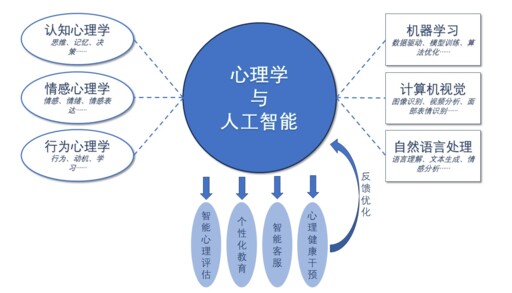


Interdisciplinary integration: How psychology and AI advance each other

Psychology and AI inform each other. Photo: PROVIDED TO CSST
The interplay between psychology and artificial intelligence has accompanied the evolution of both disciplines and grown increasingly close. Since its inception, AI has drawn on cognitive theories from psychology to simulate human thinking and learning processes. Today, informed by psychological studies of emotion and behavior, large language models (LLMs) have made remarkable progress in areas such as emotion recognition and psychological assessment. Psychology, in turn, benefits from AI’s powerful data-processing capabilities, which overcome traditional limits on sample size and analytical precision, and reveal patterns underlying complex mental activities through in-depth, large-scale analysis of behavioral data. These exchanges are driving psychology toward more intelligent and rigorous scholarship, while also enhancing AI’s ability to resonate with humans, embodying a new paradigm of multidisciplinary collaborative innovation.
Psychology helping AI understand human mind
Human psychology underlies behavior, and behavior in turn reflects mental state. By collecting large volumes of behavioral data—such as text, speech, gait, and facial expressions—together with annotated psychological data, researchers have provided the scientific foundation needed to support AI algorithms.
A research team from the Institute of Psychology at the Chinese Academy of Sciences has developed a Chinese psychological analysis system called “Wenxin” (TextMind). Compared to traditional natural language processing algorithms, this system more accurately captures text feature vectors that reflect psychological traits, and applies them to a Big Five personality identification model. When “Wenxin” analyzes Weibo users’ original posts to assess their personalities, its accuracy is significantly higher than that of questionnaire-based measurements. Moreover, this method substantially broadens the scope of measurement and improves efficiency.
AI can also generate psychological profiles based on an individual’s behavioral habits and preferences. Researchers have utilized audio analysis technology to capture tonal and rhythmic features in speech, combining them with deep learning algorithms to identify mental health risks expressed through voice. Data from facial expressions, gait, and other modalities likewise serve as behavioral indicators for assessing mental health conditions such as stress, anxiety, and emotional stability.
Even more challenging than teaching AI to understand explicit human behavior is enabling it to detect unspoken signals of psychological distress. Recently, Chinese researchers applied the “Motivation-Will Model” from psychology, tasking AI with deducing risk pathways from subtle cues and fine-tuning LLMs by generating large volumes of simulated text. Results show that this “data feedback” approach not only improves accuracy in identifying risks, but also provides timely warnings for high-risk individuals while safeguarding privacy.
AI expanding boundaries of psychological research
AI’s impact on psychology extends far beyond mere “tool upgrading”—it also expands the very frontiers of research. Traditional psychological studies often rely on carefully designed small-scale experiments conducted in controlled environments, akin to examining a miniature world under a magnifying glass. Their findings do not always generalize to real-world contexts. The integration of AI with wearable devices, mobile applications, and the Internet of Things now enables psychologists to collect large-scale, real-time behavioral and physiological data, extending research into diverse aspects of daily life and considerably enhancing the ecological validity of psychological studies.
LLMs also hold great potential for mapping relationships among socio-psychological variables. A Chinese research team analyzed social psychology articles published in 2024 in SCI/SSCI journals, using LLMs to extract variable information and relationships, and designing structured prompts for different types of relationships to invoke corresponding models. Human experts were also recruited and given the same scoring guidelines used in the prompts, allowing a direct comparison between expert judgments and LLM outputs. The findings suggest that for simple relationships, LLMs performed on par with human experts, and in some cases surpassed them. This demonstrates the promise of AI-powered automated research in the social sciences.
Advances in AI have also prompted psychologists to reconsider the nature of fundamental concepts such as memory, knowledge, and emotion. Traditional models decompose cognition into a series of modular steps, whereas AI operates in a more holistic fashion. By learning from vast data sets, AI maps inputs directly to outputs without the need for explicitly defined intermediate steps. This offers a fresh perspective for studying cognitive processes and enables psychologists to examine human thought patterns from a new dimension.
Looking ahead, the integration of psychology and AI may give rise to novel intelligent agents capable of understanding—and perhaps even experiencing—emotions. Yet as AI gradually approaches human emotional complexity, new ethical challenges may arise. Should AI’s emotions, if developed, be recognized? If humans form emotional attachments to AI, how should such relationships and responsibilities be defined? Striking a balance between emotional projection and rational judgment may be essential to fostering a healthy human-AI relationship. The interplay between psychology and AI is opening new horizons, promising not only more empathetic machines but also deeper insights into human nature.
Zhu Tingshao is a research fellow from the Institute of Psychology at the Chinese Academy of Sciences.
Editor:Yu Hui
Copyright©2023 CSSN All Rights Reserved